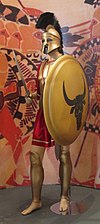Greek shield

The Greek shield of Ancient Greece was called a hoplon or aspis. It was from this word that hoplite (a Greek soldier) is derived.[1]
A hoplon was a deeply-dished shield made of wood. Some shields had a thin sheet of bronze on the outer face. This was placed just around the rim. In some periods, the shield was decorated. At other times, it remained undecorated. These large shields were designed for a mass of hoplites to push forward into the opposing army, and it was their most essential equipment.[2] The shield was carried in the left hand. It was used by Spartans as a weapon of attack.
Probably the most famous decoration is the Spartan. This was a capital lambda (Λ). From the late 5th century BC onward, Athenian hoplites usually used the Little Owl (Athena's sacred bird). The shields of Theban hoplites were sometimes decorated with a sphinx, or the club of Herakles.
References
- ↑ Fred Eugene Ray, Jr. (2011). Land battles in 5th century BC Greece: a history and analysis of 173 engagements. McFarland. p. 9. ISBN 978-0-7864-5260-6.
The word hoplon sometimes meant this piece of equipment, but the word use most often was in the plural (hopla) to describe all the tools of war (i.e., arms, with hoplites signifying a man at arms).
- ↑ Sage, Michael M (1996). Warfare in Ancient Greece: A Sourcebook. London, GBR: Routledge. pp. 281.
